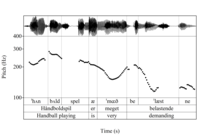The phonology of Danish is similar to that of the other closely related Scandinavian languages, Swedish and Norwegian, but it also has distinct features setting it apart. For example, Danish has a suprasegmental feature known as stød which is a kind of laryngeal phonation that is used phonemically. It also exhibits extensive lenition of plosives, which is noticeably more common than in the neighboring languages. Because of these and a few other features, spoken Danish can be challenging for Norwegians and Swedes to understand without training, although they can easily read written Danish.
Consonants
Danish has at least 17 consonant phonemes:
| Labial | Alveolar | Palatal | Velar | Uvular | Glottal | |
|---|---|---|---|---|---|---|
| Nasal | m | n | ŋ | |||
| Plosive | p b | t d | k ɡ | |||
| Fricative | f | s | (ɕ) | h | ||
| Approximant | v | ð | j | (w) | r | |
| Lateral | l |
| Phone | Phoneme | Morphophoneme | |
|---|---|---|---|
| Syllable- initial |
Syllable- final | ||
| /m/ | |m| | ||
| /n/ | |n| | ||
| /ŋ/ | — | |nɡ|, |ŋ|, |n| | |
| /p/ | |p| | — | |
| /t/ | |t| | — | |
| /k/ | |k| | — | |
| /b/ | |b| | |p, b| | |
| /d/ | |d| | |t| | |
| /ɡ/ | |ɡ| | |k| | |
| /f/ | |f| | ||
| /s/ | |s| | ||
| /sj/ | |sj| | ||
| /h/ | |h| | — | |
| /v/ | |v| | — | |
| /ð/ | — | |d| | |
| /j/ | |j| | |j, ɡ| | |
| /v/ | — | |v, ɡ| | |
| /r/ | |r| | — | |
| /r/ | — | |r| | |
| /l/ | |l| | ||
| |||
/p, t, k, h/ occur only syllable-initially and only syllable-finally. is phonemically /sj/ and is the syllable-final allophone of /v/. also occurs syllable-initially in English loans, along with [ɹ], but syllable-initial is in free variation with and these are not considered part of the phonological inventory of Danish.
/ŋ/ occurs only before short vowels and stems morphophonologically, in native words, from |nɡ| or |n| preceding |k| and, in French loans, from a distinct |ŋ|. Beyond morphological boundaries, may also appear as the result of an optional assimilation of /n/ before /k, ɡ/.
/n, t, d, s, l/ are apical alveolar , although some speakers realize /s/ dentally ([s̪]).
/p, t, k/ are voiceless aspirated, with /t/ also affricated: . The affricate is often transcribed with ⟨tˢ⟩. In some varieties of standard Danish (but not the Copenhagen dialect), /t/ is just aspirated, without the affrication.
/b, d, ɡ/ are voiceless unaspirated . In syllable codas, weak, partial voicing may accompany them especially when between voiced sounds. In spontaneous speech recorded in 1996, 38% of intervocalic /b, d, ɡ/ were voiced. In that environment, /d/ may be realized as a flap [ɾ], as in nordisk 'Nordic'. Utterance-final /b, d, ɡ/ may be realized as , particularly in distinct speech.
/h/ is only weakly fricated. Between vowels, it is often voiced [ɦ].
/v/ can be a voiced fricative [v], but is most often a voiced approximant [ʋ].
/ð/ – the so-called "soft d" (Danish: blødt d) – is a velarized laminal alveolar approximant [ð̠˕ˠ]. It is acoustically similar to the cardinal vowels [ɯ] and [ɨ]. It is commonly perceived by non-native speakers of Danish as [l]. Very rarely, /ð/ can be realized as a fricative.
Syllable-initially, /r/ is a voiced uvular fricative [ʁ] or, more commonly, an approximant [ʁ̞]. According to Nina Grønnum, the fricative variant is voiceless [χ]. Its precise place of articulation has been described as pharyngeal, or more broadly, as "supra-pharyngeal". When emphasizing a word, word-initial /r/ may be realized as a voiced uvular fricative trill [ʀ̝]. In syllable-final position, /r/ is realized as .
The alveolar realization [r] of /r/ is very rare. According to Torp (2001), it occurs in some varieties of Jutlandic dialect, and only for some speakers (mostly the elderly). The alveolar realization is considered non-standard, even in classical opera singing – it is probably the only European language in which this is the case. According to Basbøll (2005), it occurs (or used to occur until recently) in very old forms of certain conservative dialects in Northern Jutland and Bornholm.
/l, j, r/ are voiceless after /p, t, k/, where the aspiration is realized as devoicing of the following consonant, so that /tj/ is normally realized as an alveolo-palatal affricate [tɕ].
A voiced velar continuant [ɣ] occurred distinctively in older Standard Danish. Some older speakers still use it in high register, most often as an approximant [ɣ˕]. It corresponds to , after back vowels and /r/, and to /j/, after front vowels and /l/, in contemporary Standard Danish.
/j/ is elided after /iː, yː/, and possibly also after /eː, øː/, and less commonly after /ɛː, aː/. Similarly, /v/ is elided after /uː/, and possibly also after /oː/, and less commonly after /ɔː/.
Vowels
 Monophthongs of Modern Standard Danish, from Grønnum (1998a), p. 100. Unstressed are not shown, whereas is usually the same as .
Monophthongs of Modern Standard Danish, from Grønnum (1998a), p. 100. Unstressed are not shown, whereas is usually the same as . Some of Conservative Standard Danish vowels shown on a vowel chart, from Ladefoged & Johnson (2010), p. 227, based on Fischer-Jørgensen (1972)
Some of Conservative Standard Danish vowels shown on a vowel chart, from Ladefoged & Johnson (2010), p. 227, based on Fischer-Jørgensen (1972)
Modern Standard Danish has around 20 different vowel qualities. These vowels are shown below in a narrow transcription.
/ə/ and /ɐ/ occur only in unstressed syllables and thus can only be short. Long vowels may have stød, thus making it possible to distinguish 30 different vowels in stressed syllables. However, vowel length and stød are most likely features of the syllable rather than of the vowel.
The 26 vowel phonemes of Standard Danish (14 short and 12 long) correspond to 21 morphophonemes (11 short and 10 long).
| Front | Central | Back | ||||||
|---|---|---|---|---|---|---|---|---|
| unrounded | rounded | |||||||
| short | long | short | long | short | long | short | long | |
| Close | i | iː | y | yː | u | uː | ||
| Close-mid | e | eː | ø | øː | ə | o | oː | |
| Open-mid | ɛ | ɛː | œ | œː | ɐ | ɔ | ɔː | |
| Open | a | aː | ɑ | ɑː | ɒ | ɒː | ||
| Morpho- phoneme |
Tautosyllabic environment |
Phoneme | Phone | Narrow tran- scription |
Example | Note | |
|---|---|---|---|---|---|---|---|
| After | Before | ||||||
| |i| | /i/ | mis | |||||
| |iː| | /iː/ | mile | |||||
| |e| | /e/ | list | |||||
| |r| | brist | ||||||
| |eː| | /eː/ | mele | |||||
| |r| | /ɛː/ | grene | |||||
| |ɛ| | /ɛ/ | læst | |||||
| |r| | bær | ||||||
| |r| | |∅, D| | /ɛ/ or /ɑ/ | række | in innovative varieties. | |||
| /ɑ/ | kræft | ||||||
| |ɛː| | /ɛː/ | mæle | |||||
| |r| | bære | in innovative varieties. | |||||
| |r| | kræse | ||||||
| |d| | /aː/ or /ɑː/ | græde | in innovative varieties. | ||||
| |a| | ≠ |r| | |A| | /a/ | malle | |||
| /ɑ/ | takke | ||||||
| |ar| | |#| | var | Only in a handful of words. | ||||
| /ɑː/ | arne | ||||||
| |aː| | /aː/ | male | |||||
| |r| | /ɑː/ | trane | |||||
| |aːr| | har | ||||||
| |y| | /y/ | lyt | |||||
| |yː| | /yː/ | kyle | |||||
| |ø| | /ø/ | kys | |||||
| |r| | ≠ |v, j, ɡ| | grynt | in innovative varieties. | ||||
| |v| | /œ/ | drøv | |||||
| |j, ɡ| | /ɔ/ | tøj | |||||
| |øː| | /øː/ | køle | |||||
| |r| | røbe | in innovative varieties. | |||||
| |œ| | /œ/ | høns | |||||
| |r| | gør | ||||||
| |r| | grøn | ||||||
| |œː| | /œː/ | høne | Rare. | ||||
| |r| | gøre | ||||||
| |u| | /u/ | guld | |||||
| |r| | /u/ | brusk | in innovative varieties. | ||||
| |uː| | /uː/ | mule | |||||
| |r| | /uː/ or /oː/ | ruse | in innovative varieties. | ||||
| |o| | |∅, r| | /o/ | sort ('black') | ||||
| ost ('cheese') | |||||||
| |oː| | /oː/ | mole | |||||
| |ɔ| | /ɔ/ | måtte | |||||
| |ɔr| | |#| | /ɒ/ | vor | Only in a handful of words. | |||
| /ɒː/ | morse | ||||||
| |ɔːr| | tårne | ||||||
| |ɔː| | /ɔː/ | måle | |||||
| |ə| | /ə/ | hoppe | |||||
| |ər| | /ɐ/ | fatter | |||||
| |rə| | ture | After long vowels. | |||||
| |rər| | turer | ||||||
| |jə| | /jə/ | veje | See § Schwa-assimilation. | ||||
| |ɡə| | jage | ||||||
| |və| | /və/ | have | |||||
| |əd| | /əð/ | måned | |||||
| |də| | /ðə/ | bade | |||||
| |əl| | /əl/ | gammel | |||||
| |lə| | /lə/ | tale | |||||
| |nə| | /nə/ | håne | |||||
| |ən| | /ən/ | hesten | |||||
| hoppen | |||||||
| pakken | |||||||
The three way distinction in front rounded vowels /y ø œ/ is upheld only before nasals, e.g. /syns sønˀs sœns/ synes, synds, søns ('seems', 'sin's', 'son's').
/a/ and /aː/ on the one hand and /ɑ/ and /ɑː/ on the other are largely in complementary distribution. However, a two-phoneme interpretation can be justified with reference to the unexpected vowel quality in words like andre /ˈɑndrɐ/ 'others' or anderledes /ˈɑnɐˌleːðəs/ 'different', and an increasing number of loanwords.
The distinction between the short /o/ and /ɔ/ is one of the more conservative features of Danish phonology. Other Scandinavian languages feature just one short mid back vowel, usually transcribed with ⟨ɔ⟩. The long /uː/, /oː/ and /ɔː/ of Danish are also more conservative as compared with their historical counterparts in Norwegian and Swedish, which have undergone a counter-clockwise vowel shift to /ʉː, uː, oː/.
Some phonemes and phones that only occur in unstressed position often merge with full phonemes and phones:
- with , leading to a variable merger of /və/ and /o/ (the former can be or instead, in which case no merger takes place).
- /ɐ/ with /ɔ/. According to Basbøll (2005), these sounds are usually merged, the main difference being the greater variability in the realizations of /ɐ/, which only occurs in unstressed position. In the narrow phonetic transcriptions of Grønnum (2005) and Brink et al. (1991), the two sounds are treated as identical.
The vowel system is unstable, and according to a study by Ejstrup & Hansen (2004), the contemporary spoken language might be experiencing a merger of several of these vowels. The following vowel pairs may be merged by some speakers (only vowels not adjacent to |r| were analyzed):
- with (11 out of 18 speakers)
- with (7 out of 18)
- with (5 out of 18)
- with (5 out of 18)
- with (4 out of 18)
- with (3 out of 18)
- with (2 out of 18)
- with (1 out of 18)
Schwa-assimilation
In addition to /ɐ/, which stems from the fusion of |ər|, |rə|, or |rər|, /ə/ assimilates to adjacent sonorants in a variety of ways:
- /ə/ assimilates to preceding long vowels: /ˈdiːə/ → die 'nurse', /ˈduːə/ → due 'pigeon'.
- /jə/ after a long vowel other than /iː, yː/ and /və/ after a long vowel other than /uː/ become monophthongs : /ˈlɛːjə/ → læge 'doctor', /ˈlɔːvə/ → låge 'gate'. In innovative varieties, the vowels may become shorter: , .
- A sonorant consonant (/ð, l, m, n, ŋ/) and /ə/, in either order, become a syllabic consonant .
- It is longer after a short vowel than after a long one: /ˈbaːðə/ → bade 'bathe', /ˈhuːlə/ → hule 'cave', /ˈsbiðə/ → spidde 'spear', /ˈkulə/ → kulde 'cold'.
- When /ə/ is placed between two sonorant consonants, the second becomes syllabic: /ˈsaðəl/ → saddel 'saddle', /ˈhyləð/ → hyldet 'praised'.
- The place of a syllabic nasal (/ən/) assimilates to that of the preceding consonant: /ˈlɑbən/ → lappen 'the patch', /ˈlɑɡən/ → lakken 'varnishes'.
In casual speech, /ə/ may also be elided after an obstruent, for instance: /ˈmasə/ → masse 'mass'. If that occurs after a long vowel, the syllable with the elided /ə/ may be retained by lengthening the vowel preceding the consonant: /ˈhɔːbə/ → håbe 'hope'.
Glottal stop insertion
A word-initial vowel may be preceded by a glottal stop when preceded by a vowel. This is known as sprængansats.
Prosody
Stress, stød and intonation are prosodic features used in Danish phonology. Durational distinctions are also present and affected by the grammatical context, but are usually considered part of the vowel phonemes.
Stress
Stress is phonemic and distinguishes words like billigst /ˈbilisd/ ('cheapest') and bilist /biˈlisd/ ('car driver'), but such word pairs are rare. In syntactic phrases, verbs lose their stress (and stød, if any) with an object without a definite or indefinite article: e.g. ˈJens ˈspiser et ˈbrød ('Jens eats a loaf') ~ ˈJens spiser ˈbrød ('Jens eats bread'). In names, only the surname is stressed, e.g. Johanne Luise Heiberg.
Three degrees of stress - primary, secondary and unstressed - are distinguished.
Stød
Main article: StødIn a number of words, stressed syllables with a long vowel or with a short vowel and a sonorant may exhibit a prosodic feature called stød ('thrust'). Acoustically, vowels with stød tend to be a little shorter and feature creaky voice. Historically, this feature operated as a redundant aspect of stress on monosyllabic words that had either a long vowel or final voiced consonant. Since the creation of new monosyllabic words, this association with monosyllables is no longer as strong. Some other tendencies include:
- Polysyllabic words with the nominal definite suffix -et may exhibit stød
- Polysyllabic loanwords with final stress on either a long vowel or a vowel with a final sonorant typically feature stød
Diphthongs with an underlying long vowel always have stød.
Intonation

Danish intonation reflects the combination of the stress group, sentence type and prosodic phrase, where the stress group is the main intonation unit. In Copenhagen Standard Danish, the stress group mainly has a certain pitch pattern that reaches its lowest peak on the stressed syllable followed by its highest peak on the immediately following unstressed syllable, after which it declines gradually until the next stress group. The peaks of stress groups in succession will generally be lower later in the utterance. However, the realization of the pitch is different in other varieties of Danish in where the peak is located related to the stressed syllable, and Jutlandic varieties often rise to the peak of the stress group on the stressed syllable. The pitch pattern of an utterance can also reflect the type of utterance, with declaratives having a steep falling pitch and questions displaying a level pitch, with other categories in between.
The realization of stød also affects pitch, while some varieties also realize it primarily with pitch.
Text sample
The sample text is an indistinct reading of the first sentence of The North Wind and the Sun.
Orthographic version
Nordenvinden og solen kom engang i strid om, hvem af dem der var den stærkeste.
Broad phonetic transcription
References
- Basbøll (2005), pp. 75–6, 547.
- ^ Basbøll (2005), p. 64.
- Grønnum (1998a), pp. 99–100.
- Basbøll (2005), pp. 64–5.
- Basbøll (2005), p. 63.
- Basbøll (2005), p. 75.
- Basbøll (2005), pp. 60–3, 131.
- Thorborg (2003), p. 80. The author states that /s/ is pronounced with "the tip of the tongue right behind upper teeth, but without touching them." This is confirmed by the accompanying image.
- Grønnum (2005), p. 144. Only this author mentions both alveolar and dental realizations.
- Grønnum (2005), pp. 120, 303–5.
- Grønnum (2005), p. 303.
- Grønnum (2005), pp. 303–5.
- Goblirsch (2018), pp. 134–5, citing Fischer-Jørgensen (1952) and Abrahams (1949, pp. 116–21, 228–30).
- Puggaard-Rode, Horslund & Jørgensen (2022).
- ^ Grønnum (2005), p. 157.
- Basbøll (2005), p. 126.
- Basbøll (2005), p. 213.
- Basbøll (2005), pp. 61–2.
- Grønnum (2005), p. 125.
- Basbøll (2005), p. 27.
- Basbøll (2005), pp. 59, 63.
- ^ Grønnum (2003), p. 121.
- ^ Ladefoged & Maddieson (1996), p. 144.
- Haberland (1994), p. 320.
- Basbøll (2005), pp. 62, 66.
- Basbøll (2005), p. 62.
- Ladefoged & Maddieson (1996), p. 323.
- Grønnum (1998a), p. 99.
- Torp (2001), p. 78.
- Basbøll (2005), p. 218.
- Basbøll (2005), pp. 65–6.
- Grønnum (2005), p. 148.
- ^ Basbøll (2005), pp. 211–2.
- Grønnum (2005), p. 123.
- Grønnum (2005), p. 296.
- Basbøll (2005), pp. 45–7, 52, 57–9, 71, 546–7.
- Grønnum (2005), pp. 36–7, 59–61, 287–92, 420–1.
- Basbøll (2005), p. 45.
- Basbøll (2005), p. 149.
- Grønnum (2005), p. 285.
- ^ Basbøll (2005), p. 154.
- Brink et al. (1991), p. 87.
- Brink et al. (1991), p. 108.
- ^ Basbøll (2005), p. 150.
- Basbøll (2005), pp. 72, 81.
- Basbøll (2005), pp. 50–1.
- Basbøll (2005), p. 58.
- Grønnum (2005), p. 419; both sounds are transcribed as .
- Brink et al. (1991), p. 86, using ɔ in the Dania transcription.
- Ejstrup & Hansen (2004).
- ^ Grønnum (2005), pp. 186–7.
- Grønnum (2005), p. 186.
- Grønnum (2005), p. 269.
- Grønnum (2005), pp. 301–2.
- ^ Grønnum (2005), p. 187.
- Grønnum (2005), p. 302.
- Basbøll (2005), p. 317.
- Grønnum, Nina (2 February 2009). "sprængansats". Den Store Danske. lex.dk. Retrieved 12 August 2021.
- Grønnum (1998a), p. 100, 103.
- Grønnum (1998a), p. 103-104.
- Basbøll (2005), p. 87.
- ^ Haberland (1994), p. 318.
- Basbøll (2005), p. 83.
- Grønnum (2005), p. 294.
- Grønnum (1998b).
- Grønnum (1994).
- Grønnum & Tøndering (2007).
- Fischer-Jørgensen (1989).
- Kyst (2008).
- ^ Grønnum (1998a), p. 104.
Bibliography
- Abrahams, Henrik (1949), Études phonétiques sur les tendances évolutives des occlusives germaniques, Aarhus University Press
- Allan, Robin; Holmes, Philip; Lundskær-Nielsen, Tom (2011) , Danish: An Essential Grammar (2nd ed.), Abingdon: Routledge, ISBN 978-0-203-87800-2
- Basbøll, Hans (2005), The Phonology of Danish, Oxford: Oxford University Press, ISBN 0-19-151968-5
- Brink, Lars; Lund, Jørn; Heger, Steffen; Jørgensen, J. Normann (1991), Den Store Danske Udtaleordbog, Munksgaard, ISBN 87-16-06649-9
- Ejstrup, Michael; Hansen, Gert Foget (2004), Vowels in regional variants of Danish (PDF), Stockholm: Department of Linguistics, Stockholm University
- Fischer-Jørgensen, Eli (1952), "Om stemtheds assimilation", in Bach, H.; et al. (eds.), Festskrift til L. L. Hammerich, Copenhagen: G. E. C. Gad, pp. 116–129
- Fischer-Jørgensen, Eli (1972), "Formant Frequencies of Long and Short Danish Vowels", in Scherabon Firchow, Evelyn; Grimstad, Kaaren; Hasselmo, Nils; O'Neil, Wayne A. (eds.), Studies for Einar Haugen: Presented by Friends and Colleagues, The Hague: Mouton, pp. 189–213, doi:10.1515/9783110879131-017, ISBN 978-90-279-2338-7, S2CID 252892901
- Fischer-Jørgensen, Eli (1989), "Phonetic analysis of the stød in standard Danish", Phonetica, 46 (1–3): 1–59, doi:10.1159/000261828, PMID 2608724, S2CID 3227109
- Goblirsch, Kurt (2018), Gemination, Lenition, and Vowel Lengthening: On the History of Quantity in Germanic, Cambridge University Press, ISBN 978-1-107-03450-1
- Grønnum, Nina (1994), "Rhythm, duration and pitch in regional variants of standard Danish", Acta Linguistica Hafniensia, 27 (1): 189–218, doi:10.1080/03740463.1994.10420402
- Grønnum, Nina (1998a), "Illustrations of the IPA: Danish", Journal of the International Phonetic Association, 28 (1 & 2): 99–105, doi:10.1017/s0025100300006290, S2CID 249412109
- Grønnum, Nina (1998b), "Intonation in Danish", in Hirst, Daniel; Di Cristo, Albert (eds.), Intonation Systems: A Survey of Twenty Languages, Cambridge University Press, ISBN 0-521-39513-5
- Grønnum, Nina (2003), "Why are the Danes so hard to understand?" (PDF), in Jacobsen, Henrik Galberg; Bleses, Dorthe; Madsen, Thomas O.; Thomsen, Pia (eds.), Take Danish – for instance: linguistic studies in honour of Hans Basbøll, presented on the occasion of his 60th birthday, Odense: Syddansk Universitetsforlag, pp. 119–130
- Grønnum, Nina (2005), Fonetik og fonologi, Almen og Dansk (3rd ed.), Copenhagen: Akademisk Forlag, ISBN 87-500-3865-6
- Grønnum, Nina; Tøndering, John (2007), "Question intonation in non-scripted Danish dialogues", in Trouvain, J.; Barry, W. (eds.), Proceedings of the XVIth International Congress of Phonetic Sciences (PDF), University of Saarbrücken, pp. 1229–1232
- Haberland, Hartmut (1994), "Danish", in König, Ekkehard; van der Auwera, Johan (eds.), The Germanic Languages, Routledge, pp. 313–348, ISBN 1317799585
- Herslund, Michael (2002), Danish, Languages of the world. Materials 382, München: Lincom Europa, ISBN 3895863963
- Kyst, Bodil (2008), "Trykgruppens toner i århusiansk regiolekt", Danske Talesprog, 9: 1–64
- Ladefoged, Peter; Maddieson, Ian (1996), The Sounds of the World's Languages, Oxford: Blackwell, ISBN 0-631-19815-6
- Ladefoged, Peter; Johnson, Keith (2010), A Course in Phonetics (6th ed.), Boston, Massachusetts: Wadsworth Publishing, ISBN 978-1-4282-3126-9
- Maddieson, Ian; Spajić, Siniša; Sands, Bonny; Ladefoged, Peter (1993), "Phonetic structures of Dahalo", in Maddieson, Ian (ed.), UCLA working papers in phonetics: Fieldwork studies of targeted languages, vol. 84, Los Angeles: The UCLA Phonetics Laboratory Group, pp. 25–65
- Puggaard-Rode, Rasmus; Horslund, Camilla Søballe; Jørgensen, Henrik (2022), "The rarity of intervocalic voicing of stops in Danish spontaneous speech", Laboratory Phonology, 13 (1), doi:10.16995/labphon.6449, hdl:1887/3304670
- Thorborg, Lisbet (2003), Dansk udtale – øvebog, Forlaget Synope, ISBN 87-988509-4-6
- Torp, Arne (2001), "Retroflex consonants and dorsal /r/: mutually excluding innovations? On the diffusion of dorsal /r/ in Scandinavian", in van de Velde, Hans; van Hout, Roeland (eds.), 'r-atics, Brussels: Etudes & Travaux, pp. 75–90, ISSN 0777-3692
- Uldall, Hans Jørgen (1933), A Danish Phonetic Reader, The London phonetic readers, London: University of London Press
Further reading
- Basbøll, Hans (1985), "Stød in modern Danish", Folia Linguistica, 19 (1–2): 1–50, doi:10.1515/flin.1985.19.1-2.1
- Brink, Lars; Lund, Jørn (1975), Dansk rigsmål 1-2, Copenhagen: Gyldendal
- Brink, Lars; Lund, Jørn (1974), Udtaleforskelle i Danmark, Copenhagen: Gjellerup, ISBN 978-8713019465
- Grønnum, Nina (1992), The groundworks of Danish intonation, Copenhagen: Museum Tusculanum Press, ISBN 978-8772891699
- Grønnum, Nina (1996), "Danish vowels – scratching the recent surface in a phonological experiment" (PDF), Acta Linguistica Hafniensia, 28: 5–63, doi:10.1080/03740463.1996.10416062
- Grønnum, Nina (2007), Rødgrød med fløde – En lille bog om dansk fonetik, Copenhagen: Akademisk Forlag, ISBN 978-87-500-3918-1
- Heger, Steffen (1981), Sprog og lyd – Elementær dansk fonetik (2nd ed.), Copenhagen: Gjellerup, ISBN 87-500-3089-2
- Lundskær-Nielsen, Tom; Barnes, Michael; Lindskog, Annika (2005), Introduction to Scandinavian phonetics: Danish, Norwegian, and Swedish, Alfabeta, ISBN 978-8763600095
- Molbæk Hansen, Peter (1990), Udtaleordbog, Copenhagen: Gyldendal, ISBN 978-87-02-05895-6
External links
| Danish language | ||
|---|---|---|
 | ||
| Dialects |
| |
| Variants, derivatives, etc. |
| |
| Related topics | ||
| Phonologies of the world's languages | |
|---|---|
| |
| A–E | |
| F–L | |
| M–S | |
| T–Z | |